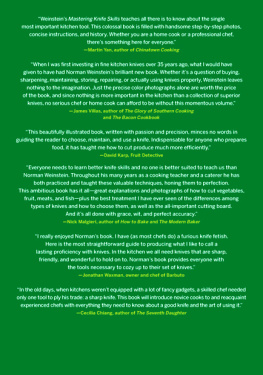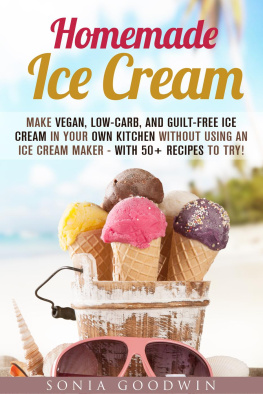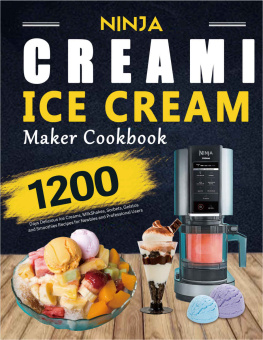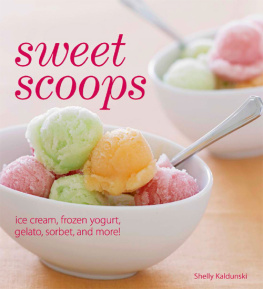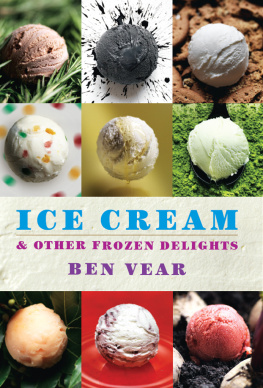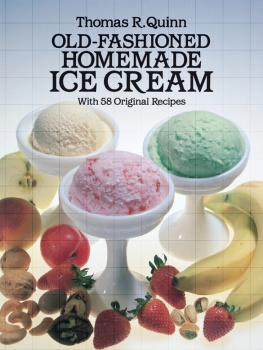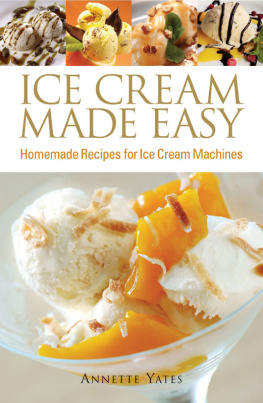The Ultimate Ice Cream Book
OVER 500 ICE CREAMS, SORBETS, GRANITAS, DRINKS, AND MORE

B R U C E W E I N S T E I N

To Mark Scarbrough,
the kindest and most generous man I know.
His taste and inspiration fill my life
as well as every recipe in this book.
Contents
W HEN I started putting together recipes for this book, I wanted to re-create ice creams with the flavors and textures found in an old-fashioned ice cream parlora place where classic ice creams and traditional toppings held court. There, handwritten blackboards announced what was made each day, and toppings such as hot fudge, marshmallow, and butterscotch were commonplace. Lemongrass-ginger sauces and cassis-cabernet reductions were simply not on the menu.
But I also wanted to create flavors for todays more adventurous palatesrefreshing flavor combinations that could satisfy even the most sophisticated among us. So Ive put together a collection of classic ice cream flavors, and then customized them with mix-ins and simple substitutions. Each basic recipe is followed by a list of variations designed to push the idea just a little, and then some more. You should even feel free to write your own variations in the margins. After all, you can have your ice cream and eat it, too.
ABOUT THE RECIPES
THERE are two basic styles of ice cream in this book: custard-style ice cream (sometimes called frozen custard, French ice cream, or gelato), which is made with eggs; and Philadelphia-style ice cream, which is made without eggs. In tasting after tasting, I found the custard-style ice creams richer than their Philadelphia-style counterparts. The Philadelphia-style ice creams, however, are much easier to make.
Re-creating the authentic custard-style ice cream of those old-fashioned ice cream emporia means using plenty of eggsa potential problem if the eggs are not properly cooked. Certainly, not all eggs contain harmful bacteria; nonetheless, it is possible to get ill from eating contaminated raw eggs. So I created recipes that call only for cooked eggs, that is, heated to a safe temperature before chilling and freezing the ice cream mixture.
Traditionally, sorbets are made with fruit, sugar, and water, while sherbets also contain egg whites or possibly milk. Today, on the other hand, most ices are called sorbets as long as they dont contain heavy cream. Indeed, I opt for a simpler, perhaps clearer distinction: ice cream vs. sorbet. Despite the fact that some would call these sherbets, I have created a few sorbets that contain egg whites and/or skim milk. In keeping with my desire for safety, all egg whites are cooked by beating in a hot sugar syrup.
Eggs present a second problem as well: how to divide them when reducing a recipe. The easiest way is to beat the total number of eggs called for in the recipe and then measure the volume. You can then use the amount you need, whether its half the volume or a third or a quarter. Cover and store any remaining eggs in the refrigerator for tomorrows scrambled eggs.
Fruit is the main flavoring for most of the ice creams and sorbets in this book. Canned or frozen fruits are acceptable for many but not all of the recipes. Canned peaches, for instance, do not have enough flavor to cut through the cream and sugar. Canned purple plums, on the other hand, make a wonderfully full-flavored ice cream. In fact, sometimes I recommend canned fruit over fresh. For example, fresh pineapple contains an enzyme that breaks down the protein in the milk, causing it to curdle. When pineapple is canned, this enzyme is destroyed, making the fruit usable in ice cream. So how do you know when to use canned, frozen, or fresh fruit? Unless otherwise specified, use fresh fruit. The recipes tell you whether canned or frozen fruit is an acceptable substitute.
Fresh fruit for ice cream should be ripe, sweet, and juicy. Taste it (if you can) before you buy it, but by all means smell it. After all, our sense of smell accounts for much of our tasting ability. Most fruits, including peaches, plums, cherries, apples, pears, mangoes, and pineapples, smell sweet and fragrant when ripe. When using canned or frozen fruit, always look for premium quality. Select canned fruit packed in juice, not heavy syrup (unless otherwise called for). Frozen fruit should be packed without syrup or sauce.
I dont recommend using artificial flavorings and extracts in most of these ice creams, but there is one exception: the only way to make good bubble gum ice cream is with artificial bubble gum flavoring. But for vanilla or almond flavor, the real thing is always best. A few years back I discovered double-strength vanilla from Penzeys in Muskego, Wisconsin (414-574-0277), and have sworn by it ever since. They also carry premium-quality spices and lavender flowers, which are called for in some of the recipes in this book.
ICE CREAM MACHINES
AN ice cream machine is essential for making good ice creams and sorbets. The machine churns the mixture as it freezes, incorporating air in the process. The result is smooth and creamy, avoiding the Popsicle syndromea solid block of cream and ice thats impossible to serve or eat. Yes, I have also seen ice cream made by stirring liquid nitrogen into sweetened, flavored heavy cream. But unless you are a research chemist and like to cook wearing thick asbestos gloves, I dont recommend this technique. In the end, theres no way around it. Unless you want to sit in a walk-in freezer, stirring a bowl of cream and fruit, you need to get a machine. Fortunately, you have a wide choice, ranging in both price and style.
The machines with built-in compressors are easiest to use. They churn and freeze at the touch of a button. These machines work fast, incorporating minimal air into the mixture, thereby turning out a dense, premium ice cream. You can also make as many batches of ice cream as you like, one right after the other. The only drawback is their hefty price tag. Plan to spend anywhere from $300 to $600.
Ice cream makers with canisters you chill in the freezer before use are also easy, and not nearly as expensive. When youre ready to make ice cream, remove the canister from the freezer, insert it into your machine, pour in the ice cream or sorbet mixture, and flip the switch or crank away. The electric type is obviously easier, but both make rich, dense ice cream. Theres only one drawback: you can make only one batch of ice cream before having to refreeze the canister, sometimes overnight. One-quart models with motors cost around $50; the equivalent hand-crank model is about $25. If you plan to make a lot of ice cream, buy two or three of these machines so you can churn multiple batches without interruption.
Ice cream makers that require ice and rock salt take longer to freeze the ice cream or sorbet, thereby incorporating more air into the mixture and producing a lighter, airier dessert. Personally I prefer the dense, rich quality of ice creams and sorbets made quickly. Its all a matter of taste, and if you want an old-fashioned ice cream maker, you can easily find hand-cranked and motorized versions. Plan to spend over $150 for a wooden model or substantially less for a plastic version.
All three types of ice cream machines do a good job of making the recipes in this book. Keep in mind that the easier the machine is to use, the more likely you are to use it. Every recipe in this book can be doubled or tripled, should you choose a large-capacity ice cream maker. Ice cream custard will keep in the refrigerator for up to two days, so multiplying a recipe allows you make fresh ice cream every day, without starting from scratch.
Next page

